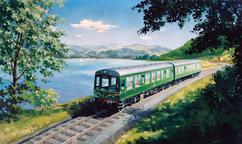

Drawing of a Buddhist stupa in Sikkim, India
- Made:
- circa 1860 in Sikkim

Drawing, pencil on paper, Boodhist Chait or sacred monument, Sikkim by an unknown artist, about 1860. Depicts a stone stupa with a man in Sikkim dress standing alongside. The title is inscribed above. From the collection of George Turnbull, Chief Engineer of the East Indian Railway. The inscription is in Turnbull’s hand.
Chaityas or stupas are mound-like structures used as a place of meditation. They usually contain relics, such as the remains of Buddhist monks or nuns. When visiting a stupa, it is customary to walk around it in a clockwise direction, in a ritual practice called pradakshina.
Writing botanical notes in 1849, the British botanist Joseph Dalton Hooker described stupas in Sikkim. His description closely matches this drawing: ‘The chait of Sikkim, borrowed from Tibet, is a square pedestal surmounted with a hemisphere, the convex end downwards, and on it is placed a cone, with a crescent on the top.’
Turnbull was usually based in what is now West Bengal. In mid-1861 the Turnbull family made the 640km trip to Darjeeling in Sikkim and spent the summer there. Perhaps Turnbull acquired, or made, this drawing while he was there.
Scottish engineer George Turnbull (1809-1889) oversaw the creation of one of the first railways in India, the East Indian Railway (EIR). The EIR ran from near Calcutta (now Kolkata), an East India Company trading post in the north-east that the Company established as the capital from 1773. The terminus was originally Benares (now Varanasi), but the line quickly extended to New Delhi in the north, which became the capital of India in 1911. Calcutta and New Delhi are over 1,300km miles from each other – further than the distance between Paris, France and Budapest, Hungary.
Turnbull collected artworks during his time in India, many of which were produced by EIR engineers. These watercolours and drawings provide a rare view of nineteenth-century India from the perspective of the British engineers designing and building the country’s first railways. The collection includes landscape scenes and portraits. While many of the landscapes show the construction of the railway, others focus entirely on India’s local architecture or its rural spaces. The portraits are of people Turnbull encountered while in India. While the portraits of British people are inscribed with their names, most of the Indian people depicted remain anonymous or identified only by their job.
The British introduced railways in India to satisfy the mounting economic and military needs of their colonial administration. They hoped that the new technology would foster an increased sense of collective identity by making it easier to travel quickly between distant regions. They also hoped the railways would socially ‘improve India’ by instilling a sense of punctuality among Indians, a quality British colonialists believed Indians lacked. The racist stereotypes underpinning these intentions, and the interconnected idea that technology could trigger social change, were common beliefs in nineteenth-century British society.
Details
- Category:
- Pictorial Collection (Railway)
- Object Number:
- 2017-7096
- Materials:
- paper (fibre product) and graphite
- type:
- drawing, pencil




